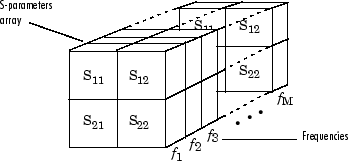S-Parameter Notation
Define S-Parameters
RF Toolbox™ software uses matrix notation to specify S-parameters. The indices of an S-parameter matrix correspond to the port numbers of the network that the data represent. For example, to define a matrix of 50-ohm, 2-port S-parameters, type:
s11 = 0.61*exp(j*165/180*pi); s21 = 3.72*exp(j*59/180*pi); s12 = 0.05*exp(j*42/180*pi); s22 = 0.45*exp(j*(-48/180)*pi); s_params = [s11 s12; s21 s22];
s_params assume:
s_params(1,1)corresponds to the reflection coefficient at port 1, S11.s_params(2,1)corresponds to the transmission coefficient from port 1 to port 2, S21.s_params(1,2)corresponds to the transmission coefficient from port 2 to port 1, S12.s_params(2,2)corresponds to the reflection coefficient at port 2, S22.
RF Toolbox software also supports three-dimensional arrays of S-parameters. The third dimension of an S-parameter array corresponds to S-parameter data at different frequencies. The following figure illustrates this convention.

Refer to S-Parameters Using Character Vector
RF Toolbox software uses character vector to refer to S-parameters in plotting and
calculation methods, such as plot. These character vector have one of the
following two forms:
'S— Use this syntax ifnm'nandmare both less than 10.'S— Use this syntax if one or both are greater than 10.n,m''Sis not a valid syntax when bothn,m'nandmare less than 10.
The indices n and m are
the port numbers for the S-parameters.
Most toolbox objects only analyze 2-port S-parameters. The following objects analyze S-parameters with more than two ports:
You can get 2-port parameters from S-parameters with an arbitrary number of ports using one or more of the following steps:
Extract 2-port S-parameters from N-port S-parameters.
Convert single-ended 4-port parameters to differential 2-port parameters.
See Convert Single-Ended S-Parameters to Mixed-Mode S-Parameters.